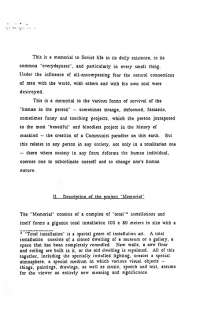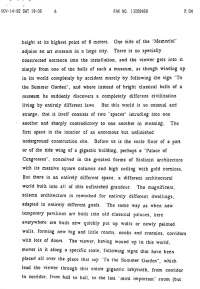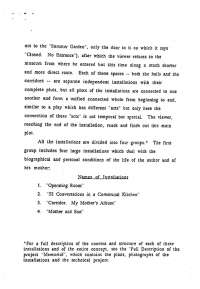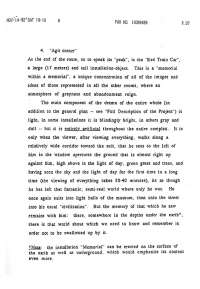Kabakov
"MEMORIAL"
Short description of the project
The Concept of the Project "Memorial"
The Russian revolution which established the "era of Socialism" is considered to be a most important event of the twentieth century. The end of that "era of Socialism" in the end of the 1980's can be considered a no less important event of our century as well. But totalitarianism, having left the political arena of Eastern Europe and the territory of the former Soviet Union, was not just a thick and heavy fog which suddenly evaporated into thin air, revealing under it a shining, cloudless earth of democracy. It remains in the consciousness and subconscious of people who lived through totalitarianism and who personally experienced its influence. But is also clear that totalitarianism isn't just a political system which fell upon mankind, but that its "seeds" live and exist in each or us. and, for the sake of the future this must not be forgotten or ignored.
This is why it would be so important to create a unique memorial to Soviet totalitarianism. But this will not be a memorial to its victims who perished in the camps -- this memorial still remains to be created and erected on that territory where all of this occurred.
This is a memorial to the those who survived, to a certain degree, but with deformed consciousness under the influence of propaganda and constant psychological repression, in its extreme forms leading to the emergence of the consciousness of a "Soviet man" with his false enthusiasm and split thinking.
This is a memorial to Soviet life in its daily existence, in its common "everydayness", and particularly in every small thing. Under the influence of all-encompassing fear the natural connections of man with the world, with others and with his own soul were destroyed.
This is a memorial to the various forms of survival of the "human in the person" -- sometimes strange, deformed, fantastic, sometimes funny and touching projects, which the person juxtaposed to the most "beautiful" and bloodiest project in the history of mankind -- the creation of a Communist paradise on this earth. But this relates to any person in any society, not only in a totalitarian one -- there where society in any form deforms the human individual, coerces one to subordinate oneself and to change one's human nature.
Description of the project "Memorial"
The "Memorial" consists of a complex of "total" installations and itself forms a gigantic total installation 100 x 80 meters in size with a _______
"Total installation" is a special genre of installation art. A total installation consists of a closed dwelling of a museum or a gallery a space that has been completely remodelled. New walls, a new floor and ceiling are built in it, or the old dwelling is repainted. All of this together, including the specially installed lighting, creates a special atmosphere, a special medium in which various visual objects things, paintings, drawings, as well as music, speech and text, assume for the viewer an entirely new meaning and significance.
height at its highest point of 8 meters. One side of the "Memorial" adjoins an art museum in a large city. There is no specially constructed entrance into the installation, and the viewer gets into it simply from one of the halls of such a museum, as though winding up in its world completely by accident merely by following the sign "To the Summer Garden", and where instead of bright classical halls of a museum he suddenly discovers a completely different civilization living by entirely different laws. But this world is so unusual and strange, that it itself consists of two "spaces" intruding into one another and sharply contradictory to one another in meaning. The first space is the interior of an enormous but unfinished underground construction site. Before us is the socle floor of a part or of the side wing of a gigantic building, perhaps a "Palace of Congresses", conceived in the greatest forms of Stalinist architecture with its massive square columns and high ceiling with gold cornices. But there is an entirely different space, a different architectural world built into all of this unfinished grandeur. The magnificent, solemn architecture is reworked for entirely different dwellings, adapted to entirely different goals. The same way as when new temporary pavilions are built into old classical palaces, here everywhere are built new quickly put up walls or newly painted walls , forming new big and little rooms, nooks and crannies , corridors with lots of doors. The viewer, having wound up in this world, moves in it along a specific route, following signs that have been placed all over the place that say "To the Summer Garden", which lead the viewer through this entire gigantic labyrinth, from corridor to corridor, from hall to hall, to the last ''most important" room (but not to the "Summer Garden", only the door to it on which it says "Closed. No Entrance"), after which the viewer returns to the museum from where he entered but this time along a much shorter and more direct route. Each of these spaces -- both the halls and the corridors -- are separate independent installations with their complete plots, but all plots of the installations are connected to one another and form a unified connected whole from beginning to end, similar to a play which has different "acts" but only here the connection of these "acts'' is not temporal but spacial. The viewer, reaching the end of the installation, reads and finds out this main plot.
All the installations are divided into four groups* The first group includes four large installations which deal with the biographical and personal conditions of the life of the author and of his mother:
Names of Installations
- "Operating Room "
- "52 Conversations in a Communal Kitchen"
- "Corridor. My Mother's Album"
- "Mother and Son"
*For a full description of the content and scructure of each of these installations and of the entire concept, see the "Full Description of the project "Memorial", which contains the plans, photographs of the installations and the technical project.
The second group deals with the world of the "personages" created by the author, the endless dance of characters, inhabitants of the communal apartment -- the main place of residence of Soviet man during the epoch of the construction of Socialism (9 installations).
("Ten Characters")
- "Communal Apartment"
- "Communal Kitchen"
- "Short Corridor"
- "Concert for Flies"
- "Unhung Paintings"
- "White Paintings"
- "Bathroom" 8 . "Club Corner" ("Studio") 9. "Repairs" ("Unfinished ")
The third group of installations takes the viewer into a no less tragic, but more, so to say, social-bureaucratic and in this sense isolated- neutral world. The following installations belong to this group:
- "Insane Asylum"
- "Big Archive"
- "Life of Flies"
- "Orphanage"
And finally, the fourth group of installations -- these are typical places of ideological influence, foll of a special tension of "Communist mysticism":
- "The Bridge"
- "Three Songs about the Mother;and"
- "Exhibit or One Book" ("Library")
- "Agit corner"
As the end of the route, so to speak its "peak", is the "Red Train Car", a large (17 meters) and tall installation-object. This is a "memorial within a memorial", a unique concentration of all of the images and ideas of those represented in all the other rooms, where an atmosphere of grayness and abandonment reign.
The main component of the drama of the entire whole (in addition to the general plan -- see "Full Description of the Project") is light, in same installations it is blindingly bright, in others gray and dull - but it is entirely artificial throughout the entire complex. lt is only when the viewer, after viewing everything, walks along a relatively wide corridor toward the exit, that he sees to the left of him in the window apertures the ground that is almost right up against him, high above is the light of day, green grass and trees, and having seen the sky and the light of day for the first time in a long time (the viewing of everything takes 30-40 minutes), its as though he has left that fantastic, semi-real world where only he was. He once again exits into light halls of the museum, then onto the street into his usual "civilization". But the memory of that which he saw remains with him: there, somewhere in the depths under the earth*, there is that world about which we need to know and remember in order not to be swallowed up by it.
*Note: the installation "Memorial" can be erected on the surface of the earth as well as underground, which would emphasize its content even more.
Kabakov
"MEMORIAL"
Short description of the project
The Concept of the Project "Memorial"
The Russian revolution which established the "era of Socialism" is considered to be a most important event of the twentieth century. The end of that "era of Socialism" in the end of the 1980's can be considered a no less important event of our century as well. But totalitarianism, having left the political arena of Eastern Europe and the territory of the former Soviet Union, was not just a thick and heavy fog which suddenly evaporated into thin air, revealing under it a shining, cloudless earth of democracy. It remains in the consciousness and subconscious of people who lived through totalitarianism and who personally experienced its influence. But is also clear that totalitarianism isn't just a political system which fell upon mankind, but that its "seeds" live and exist in each or us. and, for the sake of the future this must not be forgotten or ignored.
This is why it would be so important to create a unique memorial to Soviet totalitarianism. But this will not be a memorial to its victims who perished in the camps -- this memorial still remains to be created and erected on that territory where all of this occurred.
This is a memorial to the those who survived, to a certain degree, but with deformed consciousness under the influence of propaganda and constant psychological repression, in its extreme forms leading to the emergence of the consciousness of a "Soviet man" with his false enthusiasm and split thinking.
This is a memorial to Soviet life in its daily existence, in its common "everydayness", and particularly in every small thing. Under the influence of all-encompassing fear the natural connections of man with the world, with others and with his own soul were destroyed.
This is a memorial to the various forms of survival of the "human in the person" -- sometimes strange, deformed, fantastic, sometimes funny and touching projects, which the person juxtaposed to the most "beautiful" and bloodiest project in the history of mankind -- the creation of a Communist paradise on this earth. But this relates to any person in any society, not only in a totalitarian one -- there where society in any form deforms the human individual, coerces one to subordinate oneself and to change one's human nature.
Description of the project "Memorial"
The "Memorial" consists of a complex of "total" installations and itself forms a gigantic total installation 100 x 80 meters in size with a _______
"Total installation" is a special genre of installation art. A total installation consists of a closed dwelling of a museum or a gallery a space that has been completely remodelled. New walls, a new floor and ceiling are built in it, or the old dwelling is repainted. All of this together, including the specially installed lighting, creates a special atmosphere, a special medium in which various visual objects things, paintings, drawings, as well as music, speech and text, assume for the viewer an entirely new meaning and significance.
height at its highest point of 8 meters. One side of the "Memorial" adjoins an art museum in a large city. There is no specially constructed entrance into the installation, and the viewer gets into it simply from one of the halls of such a museum, as though winding up in its world completely by accident merely by following the sign "To the Summer Garden", and where instead of bright classical halls of a museum he suddenly discovers a completely different civilization living by entirely different laws. But this world is so unusual and strange, that it itself consists of two "spaces" intruding into one another and sharply contradictory to one another in meaning. The first space is the interior of an enormous but unfinished underground construction site. Before us is the socle floor of a part or of the side wing of a gigantic building, perhaps a "Palace of Congresses", conceived in the greatest forms of Stalinist architecture with its massive square columns and high ceiling with gold cornices. But there is an entirely different space, a different architectural world built into all of this unfinished grandeur. The magnificent, solemn architecture is reworked for entirely different dwellings, adapted to entirely different goals. The same way as when new temporary pavilions are built into old classical palaces, here everywhere are built new quickly put up walls or newly painted walls , forming new big and little rooms, nooks and crannies , corridors with lots of doors. The viewer, having wound up in this world, moves in it along a specific route, following signs that have been placed all over the place that say "To the Summer Garden", which lead the viewer through this entire gigantic labyrinth, from corridor to corridor, from hall to hall, to the last ''most important" room (but not to the "Summer Garden", only the door to it on which it says "Closed. No Entrance"), after which the viewer returns to the museum from where he entered but this time along a much shorter and more direct route. Each of these spaces -- both the halls and the corridors -- are separate independent installations with their complete plots, but all plots of the installations are connected to one another and form a unified connected whole from beginning to end, similar to a play which has different "acts" but only here the connection of these "acts'' is not temporal but spacial. The viewer, reaching the end of the installation, reads and finds out this main plot.
All the installations are divided into four groups* The first group includes four large installations which deal with the biographical and personal conditions of the life of the author and of his mother:
Names of Installations
- "Operating Room "
- "52 Conversations in a Communal Kitchen"
- "Corridor. My Mother's Album"
- "Mother and Son"
*For a full description of the content and scructure of each of these installations and of the entire concept, see the "Full Description of the project "Memorial", which contains the plans, photographs of the installations and the technical project.
The second group deals with the world of the "personages" created by the author, the endless dance of characters, inhabitants of the communal apartment -- the main place of residence of Soviet man during the epoch of the construction of Socialism (9 installations).
("Ten Characters")
- "Communal Apartment"
- "Communal Kitchen"
- "Short Corridor"
- "Concert for Flies"
- "Unhung Paintings"
- "White Paintings"
- "Bathroom" 8 . "Club Corner" ("Studio") 9. "Repairs" ("Unfinished ")
The third group of installations takes the viewer into a no less tragic, but more, so to say, social-bureaucratic and in this sense isolated- neutral world. The following installations belong to this group:
- "Insane Asylum"
- "Big Archive"
- "Life of Flies"
- "Orphanage"
And finally, the fourth group of installations -- these are typical places of ideological influence, foll of a special tension of "Communist mysticism":
- "The Bridge"
- "Three Songs about the Mother;and"
- "Exhibit or One Book" ("Library")
- "Agit corner"
As the end of the route, so to speak its "peak", is the "Red Train Car", a large (17 meters) and tall installation-object. This is a "memorial within a memorial", a unique concentration of all of the images and ideas of those represented in all the other rooms, where an atmosphere of grayness and abandonment reign.
The main component of the drama of the entire whole (in addition to the general plan -- see "Full Description of the Project") is light, in same installations it is blindingly bright, in others gray and dull - but it is entirely artificial throughout the entire complex. lt is only when the viewer, after viewing everything, walks along a relatively wide corridor toward the exit, that he sees to the left of him in the window apertures the ground that is almost right up against him, high above is the light of day, green grass and trees, and having seen the sky and the light of day for the first time in a long time (the viewing of everything takes 30-40 minutes), its as though he has left that fantastic, semi-real world where only he was. He once again exits into light halls of the museum, then onto the street into his usual "civilization". But the memory of that which he saw remains with him: there, somewhere in the depths under the earth*, there is that world about which we need to know and remember in order not to be swallowed up by it.
*Note: the installation "Memorial" can be erected on the surface of the earth as well as underground, which would emphasize its content even more.





